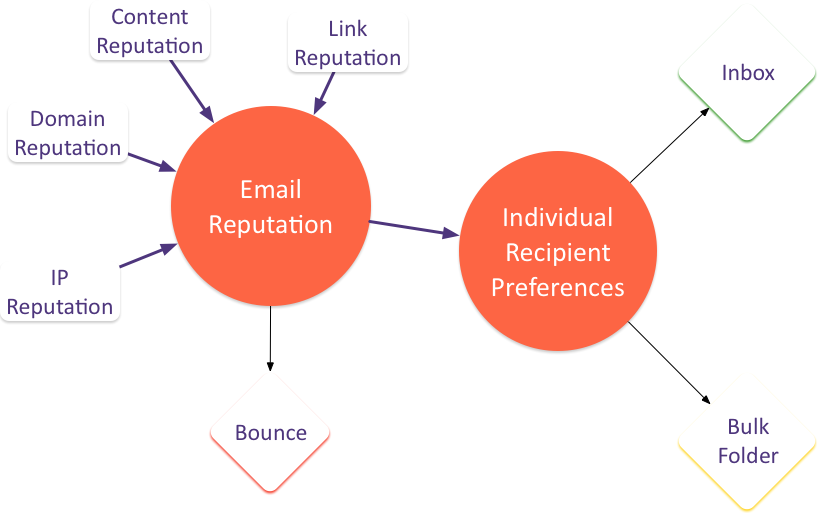Recent Posts
February 2017: The Month In Email
- laura
- Mar 4, 2017
Happy March!
As always, I blogged about best practices with subscriptions, and shared a great example of subscription transparency that I received from The Guardian. I also wrote about what happens to the small pool of people who fail to complete a confirmed opt-in (or double opt-in) subscription process. While there are many reasons that someone might not complete that process, ultimately that person has not given permission to receive email, and marketers need to respect that. I revisited an older post on permission which is still entirely relevant.
Speaking of relevance, I wrote about seed lists, which can be useful, but — like all monitoring tools — should not be treated as infallible, just as part of a larger set of information we use to assess deliverability. Spamtraps are also valuable in that larger set of tools, and I looked at some of the myths and truths about how ISPs use them. I also shared some thoughts from an industry veteran on Gmail filtering.
On the topic of industry veterans, myths and truths, I looked at the “little bit right, little bit wrong” set of opinions in the world of email. It’s interesting to see the kinds of proclamations people make and how those line up against what we see in the world.
We attended M3AAWG, which is always a wonderful opportunity for us to catch up with smart people and look at the larger email ecosystem and how important our work on messaging infrastructure and policy really is. I was glad to see the 2017 Mary Litynski Award go to Mick Moran of Interpol for his tireless work fighting abuse and the exploitation of children online. I also wrote about how people keep wanting to quote ISP representatives on policy issues, and the origin of “Barry” as ISP spokesperson (we should really add “Betty” too…)
Steve took a turn as our guest columnist for “Ask Laura” this month with a terrific post on why ESPs need so many IP addresses. As always, we’d love to get more questions on all things email — please get in touch!
End of an era
- laura
- Mar 2, 2017
A few moments ago, I cancelled one of my email addresses. This is an address that has been mine since somewhere around 1993 or 4. It was old enough to vote. And now it’s no more.
I am not even sure why I kept it for so long. It was my dialup account back when I was in grad school in Delaware. When I moved to Madison to work at the university, I kept it as a shell account and email address. I gave it up as my primary email address about the time it was bought by a giant networking company. By then I had my own domain and a mail server living behind the futon in the living room. That was back when we started WttW, somewhere around 2002.
15 years the address has mostly laid dormant. I used it for a couple yahoo groups accounts, but just lists that I lurked on.
I did use it as research for some past clients, typically the ones using affiliate marketers. “Our affiliates only ever send opt in mail!” Yeah, no. See, look, your affiliate is spamming me. My favorite was when said customer put me on the phone with the affiliate.
Confirmed Opt-In: An Old Topic Resurrected
- laura
- Mar 1, 2017
Looking back through my archives it’s been about 4 years or so since I wrote about confirmed opt in. The last post was how COI wasn’t important, but making sure you were reaching the right person was important. Of course, I’ve also written about confirmed opt-in in general and how it was a tool somewhat akin to a sledgehammer. I’m inspired to write about it today because it’s been a topic of discussion on multiple mailing lists today and I’ve already written a bunch about it (cut-n-paste-n-edit blog post! win!).
Confirmed opt-in is the process where you send an email to a recipient and ask them to click on a link to confirm they want the mail. It’s also called double opt-in, although there are some folks who think that’s “spammer” terminology. It’s not, but that’s a story for another day. The question we were discussing was what to do with the addresses that don’t click. Can you email them? Should you email them? Is there still value in them?
We have to treat the addresses as a non-homogenous pool. There are a lot of reasons confirmation links don’t get clicked.
Policy is hard
- laura
- Feb 28, 2017
We’re back at work after a trip to M3AAWG. This conference was a little different for me than previous ones. I spent a lot of time just talking with people – about email, about abuse, about the industry, about the ecosystem. Sometimes when you’re in a position like mine, you get focused way too much on the trees.
Of course, it’s the focusing on the trees that makes me good for my clients. I follow what’s going on closely, so they don’t have to. I pay attention so I can distill things into useable chunks for them to implement. Sometimes, though, I need to remember to look around and appreciate the forest. That’s what I got to do last week. I got to talk with so many great people. I got to hear what they think about email. The different perspectives are invaluable. They serve to deepen my understanding of delivery, email and where the industry is going.
One of the things that really came into focus for me is how critical protecting messaging infrastructure is. I haven’t spoken very much here about the election and the consequences and the changes and challenges we’re facing. That doesn’t mean I’m not worried about them or I don’t have some significant reservations about the new administration. It just means I don’t know how to articulate it or even if there is a solution.
The conference gave me hope. Because there are people at a lot of places who are in a place to protect users and protect privacy and protect individuals. Many of those folks were at the conference. The collaboration is still there. The concern for how we can stop or minimize bad behavior and what the implications are. Some of the most difficult conversations around policy involve the question who will this affect. In big systems, simple policies that seem like a no-brainer… aren’t. We’re seeing the effects of this with some of the realities the new administration and the Republican leaders of congress are realizing. Health care is hard, and complex. Banning an entire religion may not be a great idea. Governing is not like running a business.
Talking with smart people, especially with smart people who disagree with me, is one of the things that lets me see the forest. And I am so grateful for the time I spend with them.
Naming Names
- laura
- Feb 23, 2017
One of the things that regularly happens at email conferences is a bunch of representatives from various ISPs and sometimes deliverability companies get up on stage and entertain questions from the audience about how to get email to the inbox. I’ve sat in many of these sessions – on both sides of the stage. The questions are completely predictable.
Almost invariably, someone asks if they can quote the ISP representative, because there is this belief that if you connect a statement with an employee name that will give the statement more weight. Except it doesn’t really. People who aren’t going to listen to the advice won’t listen to it even if there are names attached.
A lot of what I publish here is based on things the ISP reps have said. In some cases the reps actually review and comment on the post before I publish it. I don’t really believe attaching names to these posts will make them any more accurate. In fact, it will decrease the amount of information I can share and will increase the amount of time it takes to get posts out.
Last night I was joking with some folks that I should just make up names for attribution. Al did that many years ago, coining the pseudonym Barry for ISP reps. Even better, many of the ISP employees adopted Barry personas and used them to participate in different online spaces. Barry A. says X. Barry B. says Y. Barry C. says W. Barry D.
It doesn’t matter what names I attach.
I think I’m going to start adding this disclaimer to the appropriate blog posts:
Any resemblance to persons living or dead should be plainly apparent to them and those that know them. All events described herein actually happened, though on occasion the author has taken certain, very small, liberties with narrative.
Because, really.
Network Abuse
- laura
- Feb 22, 2017
Many years ago, back when huge levels of spam involved hundreds of thousands of emails, there was a group of people who spent a lot of time talking about what to do about abuse. One of the distinctions we made was abuse of the net as opposed to abuse on the net. We were looking at abuse of the network, that is activity that made the internet less useable. At the time abuse of the network was primarily spam; sure, there were worms and some malicious traffic, but we were focused on email abuse.
In the last 20 years, multiple industries have arisen around network abuse. I’m sitting at a conference with hundreds of people discussing how to address and mitigate abuse online. In the context of the early discussions, we’re mostly focused on abuse of the network, not abuse on the network.
But abuse on the network is an issue. It’s a growing issue, IMO. The internet has contributed to the rise and normalization of the alt-right. Social media is a medium used for abuse on the net. Incidents range from bullying of school kids to harassment of celebrities to sharing of child abuse material. All of these things are abuse on the net. They are an issue. They need to be addressed.
Today M3AAWG gave the 2017 Mary Litynski Award to Mick Moran from Interpol for his work in fighting child exploitation and abuse on the net. As I tweeted during the session, I have a phenomenal amount of respect for Mick and people like him who work tirelessly to protect children online. I don’t talk much about child abuse materials*, but I know the problem is there and it’s bad.
One of the discussions I’ve had with some folks lately is how we can better fight abuse on the net. Many of the tools we’ve built over the years are focused on volume – more complaints mean a more serious incident. But in the case of abuse on the net, or who is wrong. volume isn’t really an issue. It’s a hard problem to solve. It’s easy to create a system that lets the good guys get information, but it’s hard to create a system that also keeps the bad guys out and prevents gaming and is effective and values single complaints of problems.
Folks like Mick, and the abuse teams at ISPs all over the world, are integral to finding and rescuing abused and exploited children. Their work is so important, and most people have no idea they exist. On top of that, the work is emotionally difficult. Some of my friends work in that space, dealing with child abuse materials, and all of them have the untold story of the one that haunts them. They don’t talk about it, but you can see it in their eyes and faces.
We can do better. We should do better. We must do better.
*Note: Throughout this post I use the term “child abuse materials” to describe what is commonly called child pornography. This is because porn isn’t necessarily bad nor abusive and the term child porn minimizes the issue. It’s important to make it clear that children are abused, sometimes for years, in order to make this material.
It's that time of year again!
- laura
- Feb 20, 2017
That time of year when my friends and colleagues join the annual migration to San Francisco for 3 days and 4 nights of messaging, mobile, malware, and midnight meetings. We’re headed up to the conference later today. Do stop by and say hi!
Read MoreWhy so many IP addresses?
- steve
- Feb 17, 2017
Hi Laura,
Read More
Merry Xmas and wishing you a Happy New Year!
I recently looked at a popular ESP’s IPv4 space and I was astounded. How does an ESP get an IP allocation of 20,480 IPs? ARIN guidelines do not allow “MX/Mailing” IPs to count towards a valid justification especially in the case when each and every IP is being used for this purpose. That’s 80 /24’s…and at a time when we are out of IPv4 space….Would love to see a blog post with your insight about this issue….
From the archives: Taking Permission
- laura
- Feb 17, 2017
From February 2010, Taking Permission.

Marketers have responded by setting up processes to “get” permission from recipients before adding them to mailing lists. They point to their privacy polices and signup forms and say “Look! the recipient gave us permission.”
In many cases, though, the permission isn’t given to the sender, permission is taken from the recipient.
Yes, permission is being TAKEN by the sender. At the point of address collection many senders set the default to be the recipient gets mail. These processes take any notion of giving permission out of the equation. The recipient doesn’t have to give permission, permission is assumed.
This isn’t real permission. No process that requires the user to take action to stop themselves from being opted in is real permission. A default state of yes takes the actual opt-in step away from the recipient.
Permission just isn’t about saying “well, we told the user if they gave us an email address we’d send them mail and they gave us an email address anyway.” Permission is about giving the recipients a choice in what they want to receive. All too often senders take permission from recipients instead of asking for permission to be given.
Since that post was originally written, some things have changed.
CASL has come into effect. CASL prevents marketers from taking permission as egregiously as what prompted this post. Under CASL, pre-checked opt-in boxes do not count as explicit permission. The law does have a category of implicit permission, which consists of an active consumer / vendor relationship. This implicit permission is limited in scope and senders have to stop mailing 2 years after the last activity.
The other change is in Gmail filters. Whatever they’re doing these days seems to really pick out mail that doesn’t have great permission. Business models that would work a few years ago are now struggling to get to the inbox at Gmail. Many of these are non-relationship emails – one off confirmations, tickets, receipts. There isn’t much of a relationship between the sender and the recipient, so the filters are biased against the mail.
Permission is still key, but these days I’m not sure even informed permission is enough.Read More
Are seed lists still relevant?
- laura
- Feb 16, 2017
Those of you who have seen some of my talks have seen this model of email delivery before. The concept is that there are a host of factors that contribute to the reputation of a particular email, but that at many ISPs the email reputation is only one factor in email delivery. Recipient preferences drive whether an email ends up in the bulk folder or the inbox.
The individual recipient preferences can be explicit or implicit. Users who add a sender to their address book, or block a sender, or create a specific filter for an email are stating an explicit preference. Additionally, ISPs monitor some user behavior to determine how wanted an email is. A recipient who moves an email from the bulk folder to the inbox is stating a preference. A person who hits “this-is-spam” is stating a preference. Other actions are also measured to give a user specific reputation for a mail.
Seed accounts aren’t like normal accounts. They don’t send mail ever. They only download it. They don’t ever dig anything out of the junk folder, they never hit this is spam. They are different than a user account – and ISPs can track this.
This tells us we have to take inbox monitoring tools with a grain of salt. I believe, though, they’re still valuable tools in the deliverability arsenal. The best use of these tools is monitoring for changes. If seed lists show less than 100% inbox, but response rates are good, then it’s unlikely the seed boxes are correctly reporting delivery to actual recipients. But if seed lists show 100% inbox and then change and go down, then that’s the time to start looking harder at the overall program.
The other time seed lists are useful is when troubleshooting delivery. It’s nice to be able to see if changes are making a difference in delivery. Again, the results aren’t 100% accurate but they are the best we have right now.
Categories
Tags
- 2010
- 2016
- 2fa
- 419
- 4xx
- 554
- 5xx
- @
- Aarp
- Abacus
- Abandoned
- Aboutmyemail
- Abuse
- Abuse Desk
- Abuse Enforcement
- Abuse Prevention
- Academia
- Accreditation
- Acme
- Acquisition
- Address Book
- Addresses
- Administrivia
- Adsp
- Advanced Delivery
- Advertiser
- Advertising
- Advice
- Affiliate
- Affiliates
- After the Email
- Alerts
- Algorithm
- Alice
- Alignment
- Allcaps
- Alt Text
- AMA
- Amazon
- Amp
- Amsterdam
- Analysis
- Anecdotes
- Anti-Spam
- Anti-Spam Laws
- Anti-Spammers
- Antwort
- AOL
- Appeals
- Appearances
- Appending
- Apple
- Arc
- Arf
- Arrest
- Arrests
- Ascii
- Asides
- Ask Laura
- Askwttw
- Assertion
- Assumptions
- ATT
- Attacks
- Attention
- Attrition
- Audit
- Authentication
- Authentication. BT
- Autonomous
- Award
- B2B
- B2C
- Backhoe
- Backscatter
- Backus-Naur Form
- Banks
- Barracuda
- Barry
- Base64
- Base85
- Bcc
- Bcp
- Bear
- Bears
- Behaviour
- Benchmark
- BESS
- Best Practices
- Bgp
- Bimi
- Bit Rot
- Bitly
- Bizanga
- Black Friday
- Blackfriday
- Blacklist
- Blacklists
- Blast
- Blo
- Block
- Blockin
- Blocking
- Blocklist
- Blocklisting
- Blocklists
- Blocks
- Blog
- Blog Links
- Blogroll
- Blogs
- Bob
- Boca
- Bofa
- Book Review
- Bot
- Botnet
- Botnets
- Bots
- Bounce
- Bounce Handling
- Bounces
- Branding
- Brands
- Breach
- Breaches
- Breech
- Bronto
- Browser
- Bsi
- Bucket
- Bulk
- Bulk Folder
- Bulk Mail
- Business
- Business Filters
- Buying Leads
- Buying Lists
- C-28
- CA
- Caa
- Cabbage
- Cache
- Cadence
- CAH
- California
- Campaign
- CAN SPAM
- Canada
- Candy
- Candycandycandy
- Canonicalization
- Canspam
- Captcha
- Career Developmnent
- Careers at WttW
- Cargo Cult
- Case Law
- Cases
- CASL
- Cat
- Cbl
- CDA
- Cert
- Certification
- CFL
- CFWS
- Change
- Charter
- Cheat
- Cheese
- Choicepoint
- Choochoo
- Christmas
- Chrome
- Cidr
- Cisco
- Civil
- Clear.net
- Clearwire.net
- Cli
- Click
- Click Through
- Click Tracking
- Clicks
- Clickthrough
- Client
- Cloudflare
- Cloudmark
- Cname
- Co-Reg
- Co-Registration
- Cocktail
- Code
- COI
- Comcast
- Comments
- Commercial
- Communication
- Community
- Comodo
- Comparison
- Competitor
- Complaint
- Complaint Rates
- Complaints
- Compliancce
- Compliance
- Compromise
- Conference
- Conferences
- Confirmation
- Confirmed (Double) Opt-In
- Confirmed Opt-In
- Congress
- Consent
- Conservatives
- Consistency
- Constant Contact
- Consultants
- Consulting
- Content
- Content Filters
- Contracts
- Cookie
- Cookie Monster
- COPL
- Corporate
- Cost
- Court Ruling
- Cox
- Cox.net
- Cpanel
- Crib
- Crime
- CRM
- Crowdsource
- Crtc
- Cryptography
- CSRIC
- CSS
- Curl
- Customer
- Cyber Monday
- Czar
- Data
- Data Hygiene
- Data Security
- Data Segmentation
- Data Verification
- DBL
- Dbp
- Ddos
- Dea
- Dead Addresses
- Dedicated
- Dedicated IPs
- Defamation
- Deferral
- Definitions
- Delays
- Delisting
- Deliverability
- Deliverability Experts
- Deliverability Improvement
- Deliverability Summit
- Deliverability Week
- Deliverability Week 2024
- Deliverabiltiy
- DeliverabiltyWeek
- Delivery Blog Carnival
- Delivery Discussion
- Delivery Emergency
- Delivery Experts
- Delivery Improvement
- Delivery Lore
- Delivery News
- Delivery Problems
- Dell
- Design
- Desks
- Dhs
- Diagnosis
- Diff
- Dig
- Direct Mag
- Direct Mail
- Directives
- Discounts
- Discovery
- Discussion Question
- Disposable
- Dk
- DKIM
- Dkimcore
- DMA
- Dmarc
- DNS
- Dnsbl
- Dnssec
- Docs
- Doingitright
- Domain
- Domain Keys
- Domain Reputation
- DomainKeys
- Domains
- Domains by Proxy
- Dontpanic
- Dot Stuffing
- Dotcom
- Double Opt-In
- Dublin
- Dyn
- Dynamic Email
- E360
- Earthlink
- Ec2
- Ecoa
- Economics
- ECPA
- Edatasource
- Edns0
- Eec
- Efail
- Efax
- Eff
- Election
- Email Address
- Email Addresses
- Email Change of Address
- Email Client
- Email Design
- Email Formats
- Email Marketing
- Email Strategy
- Email Verification
- Emailappenders
- Emailgeeks
- Emails
- Emailstuff
- Emoji
- Emoticon
- Encert
- Encryption
- End User
- Endusers
- Enforcement
- Engagement
- Enhanced Status Code
- Ennui
- Entrust
- Eol
- EOP
- Epsilon
- Esp
- ESPC
- ESPs
- EU
- Ev Ssl
- Evaluating
- Events
- EWL
- Exchange
- Excite
- Expectations
- Experience
- Expires
- Expiring
- False Positives
- FAQ
- Fathers Day
- Fbl
- FBL Microsoft
- FBLs
- Fbox
- FCC
- Fcrdns
- Featured
- Fedex
- Feds
- Feedback
- Feedback Loop
- Feedback Loops
- Fiction
- Filter
- Filter Evasion
- Filtering
- Filterings
- Filters
- Fingerprinting
- Firefox3
- First Amendment
- FISA
- Flag Day
- Forensics
- Format
- Formatting
- Forms
- Forwarding
- Fraud
- Freddy
- Frequency
- Friday
- Friday Spam
- Friendly From
- From
- From Address
- FTC
- Fussp
- Gabbard
- GDPR
- Geoip
- Gevalia
- Gfi
- Git
- Giveaway
- Giving Up
- Global Delivery
- Glossary
- Glyph
- Gmail
- Gmails
- Go
- Godaddy
- Godzilla
- Good Email Practices
- Good Emails in the Wild
- Goodmail
- Google Buzz
- Google Postmaster Tools
- Graphic
- GreenArrow
- Greylisting
- Greymail
- Groupon
- GT&U
- Guarantee
- Guest Post
- Guide
- Habeas
- Hack
- Hacking
- Hacks
- Hall of Shame
- Harassment
- Hard Bounce
- Harvesting
- Harvey
- Hash
- Hashbusters
- Headers
- Heartbleed
- Hearts
- HELO
- Help
- Henet
- Highspeedinternet
- Hijack
- History
- Holiday
- Holidays
- Holomaxx
- Hostdns4u
- Hostile
- Hostname
- Hotmail
- How To
- Howto
- Hrc
- Hsts
- HTML
- HTML Email
- Http
- Huey
- Humanity
- Humor
- Humour
- Hygiene
- Hypertouch
- I18n
- ICANN
- Icloud
- IContact
- Identity
- Idiots
- Idn
- Ietf
- Image Blocking
- Images
- Imap
- Inbox
- Inbox Delivery
- Inboxing
- Index
- India
- Indiegogo
- Industry
- Infection
- Infographic
- Information
- Inky
- Inline
- Innovation
- Insight2015
- Integration
- Internationalization
- Internet
- Intuit
- IP
- IP Address
- Ip Addresses
- IP Repuation
- IP Reputation
- IPhone
- IPO
- IPv4
- IPv6
- Ironport
- Ironport Cisco
- ISIPP
- ISP
- ISPs
- J.D. Falk Award
- Jail
- Jaynes
- JD
- Jobs
- Json
- Junk
- Juno/Netzero/UOL
- Key Rotation
- Keybase
- Keynote
- Kickstarter
- Kraft
- Laposte
- Lavabit
- Law
- Laws
- Lawsuit
- Lawsuits
- Lawyer
- Layout
- Lead Gen
- Leak
- Leaking
- Leaks
- Legal
- Legality
- Legitimate Email Marketer
- Letsencrypt
- Letstalk
- Linked In
- Links
- List Hygiene
- List Management
- List Purchases
- List the World
- List Usage
- List-Unsubscribe
- Listing
- Listmus
- Lists
- Litmus
- Live
- Livingsocial
- London
- Lookup
- Lorem Ipsum
- Lycos
- Lyris
- M3AAWG
- Maawg
- MAAWG2007
- Maawg2008
- MAAWG2012
- MAAWGSF
- Machine Learning
- Magill
- Magilla
- Mail Chimp
- Mail Client
- MAIL FROM
- Mail Privacy Protection
- Mail Problems
- Mail.app
- Mail.ru
- Mailboxes
- Mailchimp
- Mailgun
- Mailing Lists
- Mailman
- Mailop
- Mainsleaze
- Maitai
- Malicious
- Malicious Mail
- Malware
- Mandrill
- Maps
- Marketer
- Marketers
- Marketing
- Marketo
- Markters
- Maths
- Mcafee
- Mccain
- Me@privacy.net
- Measurements
- Media
- Meh
- Meltdown
- Meme
- Mentor
- Merry
- Message-ID
- Messagelabs
- MessageSystems
- Meta
- Metric
- Metrics
- Micdrop
- Microsoft
- Milter
- Mime
- Minimal
- Minshare
- Minute
- Mit
- Mitm
- Mobile
- Models
- Monitoring
- Monkey
- Monthly Review
- Mpp
- MSN/Hotmail
- MSN/Hotmail
- MTA
- Mua
- Mutt
- Mx
- Myths
- Myvzw
- Needs Work
- Netcat
- Netsol
- Netsuite
- Network
- Networking
- New Year
- News
- News Articles
- Nhi
- NJABL
- Now Hiring
- NTP
- Nxdomain
- Oath
- Obituary
- Office 365
- Office365
- One-Click
- Only Influencers
- Oops
- Opaque Cookie
- Open
- Open Detection
- Open Rate
- Open Rates
- Open Relay
- Open Tracking
- Opendkim
- Opens
- Openssl
- Opt-In
- Opt-Out
- Optonline
- Oracle
- Outage
- Outages
- Outblaze
- Outlook
- Outlook.com
- Outrage
- Outreach
- Outsource
- Ownership
- Owning the Channel
- P=reject
- Pacer
- Pander
- Panel
- Password
- Patent
- Paypal
- PBL
- Penkava
- Permission
- Personalities
- Personalization
- Personalized
- Pgp
- Phi
- Philosophy
- Phish
- Phishers
- Phishing
- Phising
- Photos
- Pii
- PIPA
- PivotalVeracity
- Pix
- Pluscachange
- Podcast
- Policies
- Policy
- Political Mail
- Political Spam
- Politics
- Porn
- Port25 Blocking
- Postfix
- Postmaster
- Power MTA
- Practices
- Predictions
- Preferences
- Prefetch
- Preview
- Primers
- Privacy
- Privacy Policy
- Privacy Protection
- Private Relay
- Productive Mail
- Promotions
- Promotions Tab
- Proofpoint
- Prospect
- Prospecting
- Protocols
- Proxy
- Psa
- PTR
- Public Suffix List
- Purchased
- Purchased Lists
- Purchases
- Purchasing Lists
- Questions
- Quoted Printable
- Rakuten
- Ralsky
- Rant
- Rate Limiting
- Ray Tomlinson
- Rc4
- RDNS
- Re-Engagement
- Read
- Ready to Post
- Readytopost
- Real People
- Realtime Address Verification
- Recaptcha
- Received
- Receivers
- Recipient
- Recipients
- Redirect
- Redsnapper
- Reference
- Registrar
- Registration
- Rejection
- Rejections
- Rejective
- Relationship
- Relevance
- Relevancy
- Removals
- Render Rate
- Rendering
- Repost
- Repudiation
- Reputation
- Requirements
- Research
- Resources
- Responsive
- Responsive Design
- Responsys
- Retail
- Retired Domains
- Retro
- Return Path
- Return Path Certified
- ReturnPath
- Reunion.com
- Reverse Dns
- RFC
- RFC2047
- RFC2821/2822
- RFC5321/5322
- RFC5322
- RFC8058
- RFC821/822
- RFCs
- Roadr
- RoadRunner
- Rodney Joffe
- ROKSO
- Role Accounts
- Rollout
- RPost
- RPZ
- Rule 34
- Rules
- Rum
- Rustock
- S.1618
- SaaS
- Sales
- Salesforce
- Sass
- SBCGlobal
- Sbl
- Scam
- Scammers
- Scams
- Scanning
- Scraping
- Screamer
- Screening
- Script
- Sec
- Secure
- Security
- Segmentation
- Selligent
- Send
- Sender
- Sender Score
- Sender Score Certified
- Senderbase
- Senderid
- Senders
- Senderscore
- Sendgrid
- Sending
- Sendy
- Seo
- Service
- Services
- Ses
- Seth Godin
- SFDC
- SFMAAWG2009
- SFMAAWG2010
- SFMAAWG2014
- Shared
- Shell
- Shouting
- Shovel
- Signing
- Signups
- Silly
- Single Opt-In
- Slack
- Slicing
- Smarthost
- Smiley
- Smime
- SMS
- SMTP
- Snds
- Snowshoe
- Soa
- Socia
- Social Media
- Social Networking
- Soft Bounce
- Software
- Sony
- SOPA
- Sorbs
- Spam
- Spam Blocking
- Spam Definition
- Spam Filtering
- Spam Filters
- Spam Folder
- Spam Law
- Spam Laws
- Spam Reports
- Spam Traps
- Spam. IMessage
- Spamarrest
- Spamassassin
- Spamblocking
- Spamcannibal
- Spamcon
- Spamcop
- Spamfiltering
- Spamfilters
- Spamfolder
- Spamhaus
- Spamhause
- Spammer
- Spammers
- Spammest
- Spamming
- Spamneverstops
- Spamresource
- Spamtrap
- Spamtraps
- Spamza
- Sparkpost
- Speaking
- Special Offers
- Spectre
- SPF
- Spoofing
- SproutDNS
- Ssl
- Standards
- Stanford
- Starttls
- Startup
- State Spam Laws
- Statistics
- Storm
- Strategy
- Stunt
- Subject
- Subject Lines
- Subscribe
- Subscriber
- Subscribers
- Subscription
- Subscription Process
- Success Stories
- Suing
- Suppression
- Surbl
- Sureclick
- Suretymail
- Survey
- Swaks
- Syle
- Symantec
- Tabbed Inbox
- Tabs
- Tagged
- Tagging
- Target
- Targeting
- Techincal
- Technical
- Telnet
- Template
- Tempo
- Temporary
- Temporary Failures
- Terminology
- Testing
- Text
- Thanks
- This Is Spam
- Throttling
- Time
- Timely
- TINS
- TLD
- Tlp
- TLS
- TMIE
- Tmobile
- Too Much Mail
- Tool
- Tools
- Toomuchemail
- Tor
- Trademark
- Traffic Light Protocol
- Tragedy of the Commons
- Transactional
- Transition
- Transparency
- Traps
- Travel
- Trend/MAPS
- Trend Micro
- Trend/MAPS
- Trigger
- Triggered
- Troubleshooting
- Trustedsource
- TWSD
- Txt
- Types of Email
- Typo
- Uce
- UCEprotect
- Unblocking
- Uncategorized
- Undisclosed Recipients
- Unexpected Email
- Unicode
- Unroll.me
- Unsolicited
- Unsubcribe
- Unsubscribe
- Unsubscribed
- Unsubscribes
- Unsubscribing
- Unsubscription
- Unwanted
- URIBL
- Url
- Url Shorteners
- Usenet
- User Education
- Utf8
- Valentine's Day
- Validation
- Validity
- Value
- Valueclick
- Verification
- Verizon
- Verizon Media
- VERP
- Verticalresponse
- Vetting
- Via
- Video
- Violence
- Virginia
- Virtumundo
- Virus
- Viruses
- Vmc
- Vocabulary
- Vodafone
- Volume
- Vzbv
- Wanted Mail
- Warmup
- Weasel
- Webinar
- Webmail
- Weekend Effect
- Welcome Emails
- White Space
- Whitelisting
- Whois
- Wiki
- Wildcard
- Wireless
- Wiretapping
- Wisewednesday
- Women of Email
- Woof
- Woot
- Wow
- Wtf
- Wttw in the Wild
- Xbl
- Xfinity
- Xkcd
- Yahoo
- Yahoogle
- Yogurt
- Zoidberg
- Zombie
- Zombies
- Zoominfo
- Zurb